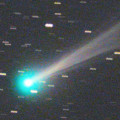
|
Now it is 4.1 mag (Sept. 9, Martin Masek). It will approach to Sun down to 0.22 a.u. and brighten up to 2 mag in mid September. It will fade out rapidly after that. Now it is not observable. It will appear in October in the Southern Hemisphere, or in November in the Northern Hemisphere.
Date(TT) R.A. (2000) Decl. Delta r Elong. m1 Best Time(A, h)
Sept. 9 10 16.26 22 52.8 0.867 0.372 21 4.4 4:11 (244, 3)
Sept.16 12 6.17 11 33.8 0.880 0.233 11 2.4 19:31 (107, -6)
|

|
It is expected to brighten up to 7.5 mag in October. Now it is 10.2 mag (Sept. 5, Thomas Lehmann). It will turn to fade out rapidly after brightening. In the Northern Hemisphere, it stays observable in good condition. In the Southern Hemisphere, it will be getting higher gradually.
Date(TT) R.A. (2000) Decl. Delta r Elong. m1 Best Time(A, h)
Sept. 9 3 45.91 42 57.5 0.416 1.160 100 9.0 4:11 (208, 81)
Sept.16 4 43.61 41 10.5 0.394 1.125 97 8.5 4:17 (233, 79)
|

|
Now it is 9.6 mag (Aug. 27, Juan Jose Gonzalez). Fading gradually. In the Northern Hemisphere, it will be getting lower gradually. In the Southern Hemisphere, it stays observable in good condition.
Date(TT) R.A. (2000) Decl. Delta r Elong. m1 Best Time(A, h)
Sept. 9 2 29.76 -17 8.5 1.876 2.632 129 9.6 3:21 ( 0, 38)
Sept.16 2 14.78 -22 3.5 1.855 2.674 136 9.6 2:38 ( 0, 33)
|
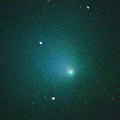
|
It will brighten up to 7.5 mag in October. Now it is 11.3 mag (Sept. 5, Thomas Lehmann). It will turn to fade out rapidly after brightening. It will be unobservable soon in the Southern Hemisphere, or in October in the Northern Hemisphere.
Date(TT) R.A. (2000) Decl. Delta r Elong. m1 Best Time(A, h)
Sept. 9 7 11.70 33 26.1 0.995 1.019 61 10.3 4:11 (255, 43)
Sept.16 8 9.96 31 0.8 0.930 0.901 55 9.8 4:17 (255, 38)
|

|
It brightened up to 7.8 mag in late July (July 20, Thomas Lehmann). Now it is 10.9 mag (Sept. 3, Thomas Lehmann). Fading gradually. It will be unobservable in October. But it will be observable again in November in the Northern Hemisphere, or in December in the Southern Hemisphere.
Date(TT) R.A. (2000) Decl. Delta r Elong. m1 Best Time(A, h)
Sept. 9 14 51.87 -16 46.7 1.830 1.584 59 10.8 19:42 ( 59, 13)
Sept.16 14 51.33 -15 26.3 2.023 1.620 52 11.1 19:31 ( 63, 11)
|
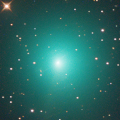
|
It brightened up to 8.4 mag in late July (July 22, Thomas Lehmann). Now it is 10.7 mag (Aug. 29, Masayoshi Yoshimi). Fading rapidly. It will be fainter than 18 mag in November. It stays observable in good condition.
Date(TT) R.A. (2000) Decl. Delta r Elong. m1 Best Time(A, h)
Sept. 9 22 7.45 -3 31.4 0.514 1.509 164 11.0 22:55 ( 0, 51)
Sept.16 22 12.70 -10 59.4 0.607 1.586 158 11.8 22:33 ( 0, 44)
|
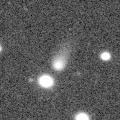
|
It is expected to brighten up to 7 mag in early 2024. Now it is 12.7 mag (Aug. 21, Chris Wyatt). It will brighten rapidly after this. In the Northern Hemisphere, it is not observable now, but it will appear in November. It locates somewhat low in the Southern Hemisphere. But it will become high in winter. The brightness evolution slowed down since May.
Date(TT) R.A. (2000) Decl. Delta r Elong. m1 Best Time(A, h)
Sept. 9 9 11.23 -29 3.8 3.179 2.561 44 11.6 4:11 (296,-14)
Sept.16 9 26.90 -30 4.6 3.100 2.487 44 11.4 4:17 (299,-12)
|

|
It brightened up to 8 mag from 2022 summer to 2023 spring. Now it is 11.8 mag (Aug. 24, Ken-ichi Kadota). It stays 12 mag for a while. In the Northern Hemisphere, it will be getting higher gradually. In the Southern Hemisphere, it stays observable in good condition.
Date(TT) R.A. (2000) Decl. Delta r Elong. m1 Best Time(A, h)
Sept. 9 6 48.13 -8 12.9 3.875 3.588 66 11.9 4:11 (301, 25)
Sept.16 6 49.67 -8 12.9 3.845 3.652 71 12.0 4:17 (308, 30)
|
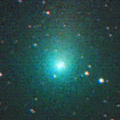
|
It brightened up to 9.5 mag from winter to early spring (Jan. 30, Katsumi Yoshimoto). Now it is 12.2 mag (Aug. 29, Osamu Miyazaki). It will fade out rapidly after this. It stays observable in good condition.
Date(TT) R.A. (2000) Decl. Delta r Elong. m1 Best Time(A, h)
Sept. 9 23 34.49 12 32.5 2.062 3.031 160 12.7 0:26 ( 0, 68)
Sept.16 23 22.80 9 9.3 2.105 3.095 167 12.9 23:41 ( 0, 64)
|
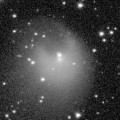
|
It returns for the first time in 70 years. It will brighten up to 4.5 mag in 2024 spring. It suddenly brightened in outburst by 5 mag up to 11.5 mag on July 20 (E. Tamas, Francois Kugel). Now it is 11.6 mag (Sept. 5, Ken-ichi Kadota). Brightening gradually. In the Northern Hemisphere, it stays observable in good condition. In the Southern Hemisphere, it will be unobservable in October.
Date(TT) R.A. (2000) Decl. Delta r Elong. m1 Best Time(A, h)
Sept. 9 17 20.86 50 48.7 3.236 3.351 87 12.9 19:42 (140, 67)
Sept.16 17 18.95 49 34.7 3.195 3.274 85 13.1 19:31 (134, 65)
|

|
Now it is 13.7 mag (July 14, Chris Wyatt). It stays 13 mag for a while. In the Northern Hemisphere, it is not observable now, but it will appear in October. In the Southern Hemisphere, it will be getting higher gradually.
Date(TT) R.A. (2000) Decl. Delta r Elong. m1 Best Time(A, h)
Sept. 9 10 36.61 -17 1.4 4.809 3.909 23 13.0 4:11 (274,-25)
Sept.16 10 38.74 -18 15.3 4.821 3.933 25 13.1 4:17 (279,-19)
|

|
It will approach to Earth down to 0.2 a.u. in November, and it is expected to brighten up to 7.5 mag. Now it is 13.2 mag (Sept. 4, Thomas Lehmann). It will brighten rapidly after this. In the Northern Hemisphere, it will be getting higher gradually. In the Southern Hemisphere, it is not observable now, but it will appear in November.
Date(TT) R.A. (2000) Decl. Delta r Elong. m1 Best Time(A, h)
Sept. 9 11 44.86 43 29.1 1.871 1.255 38 13.8 19:42 (135, 13)
Sept.16 11 48.84 43 46.7 1.733 1.176 40 13.4 19:31 (136, 11)
|

|
It brightened up to 8.3 mag in 2021-2022 winter (Jan. 6, 2022, Toshiyuki Takahashi). Now it is 13.2 mag (July 14, Chris Wyatt). It stays 14 mag for a while. In the Northern Hemisphere, it is not observable now, but it will appear in November. In the Southern Hemisphere, it will be getting higher gradually.
Date(TT) R.A. (2000) Decl. Delta r Elong. m1 Best Time(A, h)
Sept. 9 10 30.81 -34 32.7 7.019 6.295 41 13.5 4:11 (292,-32)
Sept.16 10 36.42 -35 17.4 7.071 6.339 40 13.6 4:17 (296,-27)
|

|
Now it is 13.4 mag (Sept. 3, Thomas Lehmann). Fading slowly. In the Northern Hemisphere, it is not observable now. It was expected to brighten up to 10 mag from spring to summer. However, it is fainter than originally expected.
Date(TT) R.A. (2000) Decl. Delta r Elong. m1 Best Time(A, h)
Sept. 9 11 32.66 -74 59.3 3.308 3.299 80 13.5 19:42 ( 18,-39)
Sept.16 11 38.32 -74 55.7 3.386 3.324 77 13.6 19:31 ( 18,-40)
|
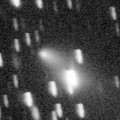
|
Now it is 14.2 mag (Sept. 5, Thomas Lehmann). It will fade out rapidly after this. In the Northern Hemisphere, it stays observable in good condition. In the Southern Hemisphere, it will be unobservable soon.
Date(TT) R.A. (2000) Decl. Delta r Elong. m1 Best Time(A, h)
Sept. 9 2 41.63 51 7.3 1.287 1.853 107 13.8 3:33 (180, 74)
Sept.16 2 36.20 55 39.2 1.279 1.883 110 13.9 3:00 (180, 69)
|
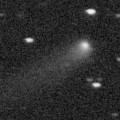
|
Now it is 14.0 mag (Aug. 24, Hiroshi Abe). Fading slowly. It stays observable in good condition.
Date(TT) R.A. (2000) Decl. Delta r Elong. m1 Best Time(A, h)
Sept. 9 1 20.51 7 29.3 2.514 3.384 144 13.8 2:12 ( 0, 63)
Sept.16 1 3.38 7 11.1 2.464 3.404 155 13.8 1:27 ( 0, 62)
|

|
Now it is 12.3 mag (Aug. 26, Katsumi Yoshimoto). In the Northern Hemisphere, it will be getting higher gradually. It locates somewhat low in the Southern Hemisphere.
Date(TT) R.A. (2000) Decl. Delta r Elong. m1 Best Time(A, h)
Sept. 9 8 16.39 22 24.6 6.811 6.134 44 14.1 4:11 (260, 25)
Sept.16 8 20.87 22 8.2 6.729 6.136 50 14.0 4:17 (264, 31)
|

|
The ATLAS search program detected its cometary activity in April. It continues to be brightening even after the perihelion passage. Now it is 13.9 mag (Aug. 28, Ken-ichi Kadota). It will fade out rapidly after this. It locates somewhat low in the Northern Hemisphere. But it will become high in autumn. In the Southern Hemisphere, it stays observable in good condition.
Date(TT) R.A. (2000) Decl. Delta r Elong. m1 Best Time(A, h)
Sept. 9 23 49.65 -27 29.4 2.054 3.002 155 14.1 0:41 ( 0, 28)
Sept.16 23 45.71 -27 27.3 2.091 3.034 155 14.1 0:09 ( 0, 28)
|

|
Now it is 13.9 mag (Sept. 5, Ken-ichi Kadota). It will fade out rapidly after this. It will be fainter than 18 mag in December. It stays observable in good condition.
Date(TT) R.A. (2000) Decl. Delta r Elong. m1 Best Time(A, h)
Sept. 9 19 32.55 -1 1.1 1.440 2.191 126 14.3 20:20 ( 0, 54)
Sept.16 19 36.64 -1 30.5 1.521 2.214 121 14.6 19:57 ( 0, 54)
|
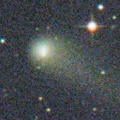
|
It brightened up to 11.1 mag in early 2022 (Mar. 31, 2022, F. Kugel, J.-G. Bosch, J. Nicolas). Now it is 14.1 mag (Sept. 5, Ken-ichi Kadota). It stays 15 mag for a while. In the Northern Hemisphere, it will be getting lower gradually. But it will be getting higher again after December. In the Southern Hemisphere, it will be unobservable in October.
Date(TT) R.A. (2000) Decl. Delta r Elong. m1 Best Time(A, h)
Sept. 9 15 30.87 18 15.6 5.977 5.631 65 14.3 19:42 ( 83, 42)
Sept.16 15 35.13 17 50.6 6.083 5.667 61 14.4 19:31 ( 85, 39)
|
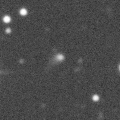
|
Now it is 15.6 mag (July 8, Thomas Lehmann). Brightening slowly. In the Northern Hemisphere, it will be getting higher gradually. It locates somewhat low in the Southern Hemisphere. But it will become high in autumn. It is expected to brighten up to 12 mag from 2024 to 2025.
Date(TT) R.A. (2000) Decl. Delta r Elong. m1 Best Time(A, h)
Sept. 9 9 30.03 3 46.0 5.794 4.894 24 14.6 4:11 (266, 0)
Sept.16 9 32.76 3 54.4 5.701 4.856 29 14.6 4:17 (270, 7)
|
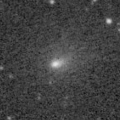
|
Now it is 14.3 mag (Aug. 22, Thomas Lehmann). It will fade out rapidly after this. It will be fainter than 18 mag in November. In the Northern Hemisphere, it will be getting lower gradually. In the Southern Hemisphere, it stays observable in good condition.
Date(TT) R.A. (2000) Decl. Delta r Elong. m1 Best Time(A, h)
Sept. 9 18 55.50 -9 57.1 1.079 1.784 117 14.7 19:43 ( 0, 45)
Sept.16 18 51.23 -16 30.1 1.244 1.845 109 15.1 19:31 ( 6, 38)
|
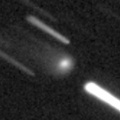
|
Now it is 14.8 mag (Aug. 18, Ken-ichi Kadota). It stays 14 mag for a while. It will be unobservable in October in the Southern Hemisphere, or in November in the Northern Hemisphere. But it will be observable again in December. It is expected to brighten up to 12.5 mag in 2024 spring. At the high light, it will be observable in excellent condition in the Southern Hemisphere, but it will be low in the Northern Hemisphere.
Date(TT) R.A. (2000) Decl. Delta r Elong. m1 Best Time(A, h)
Sept. 9 15 9.14 3 59.9 3.683 3.300 60 14.7 19:42 ( 72, 29)
Sept.16 15 7.97 2 26.3 3.752 3.260 53 14.7 19:31 ( 74, 25)
|

|
Now it is 14.3 mag (July 7, Thomas Lehmann). Fading slowly. In the Northern Hemisphere, it is not observable now. It stays extremely low in the Southern Hemisphere. But it will become high in winter.
Date(TT) R.A. (2000) Decl. Delta r Elong. m1 Best Time(A, h)
Sept. 9 11 32.93 -48 51.6 3.002 2.556 54 14.9 19:42 ( 52,-38)
Sept.16 11 56.16 -49 7.2 3.095 2.605 52 15.0 19:31 ( 51,-37)
|
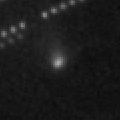
|
It brightened very rapidly. Now it is 15.2 mag (Aug. 23, ATLAS South Africa). It will fade out rapidly after this. It will be fainter than 18 mag in December. In the Northern Hemisphere, it is not observable now, but it will appear in November. In the Southern Hemisphere, it will be getting lower gradually after this, and it will be unobservable in October.
Date(TT) R.A. (2000) Decl. Delta r Elong. m1 Best Time(A, h)
Sept. 9 14 1.50 -24 55.5 2.496 2.040 52 15.0 19:42 ( 60, -1)
Sept.16 14 5.31 -22 53.1 2.620 2.042 45 15.1 19:31 ( 64, -3)
|

|
It will brighten up to 14 mag from 2024 to 2025. Now it is 15.2 mag (July 22, ATLAS Chile). It stays 15 mag for a while. In the Northern Hemisphere, it is not observable now, but it will appear in November. It locates somewhat low in the Southern Hemisphere. But it will become high in autumn.
Date(TT) R.A. (2000) Decl. Delta r Elong. m1 Best Time(A, h)
Sept. 9 10 33.73 -28 1.0 6.510 5.710 34 15.1 4:11 (285,-30)
Sept.16 10 40.76 -28 24.1 6.493 5.684 33 15.1 4:17 (289,-25)
|
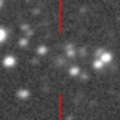
|
Now it is 14.6 mag (Aug. 5, J. L. Virlichie, P. Traverse, H. Roy, G. Houdin). Fading slowly. In the Northern Hemisphere, it will be unobservable in January. In the Southern Hemisphere, it stays observable in good condition.
Date(TT) R.A. (2000) Decl. Delta r Elong. m1 Best Time(A, h)
Sept. 9 18 2.82 -32 58.7 2.497 2.920 104 15.1 19:42 ( 11, 21)
Sept.16 18 8.32 -33 23.7 2.592 2.924 99 15.2 19:31 ( 14, 20)
|

|
It approached to Earth down to 0.29 a.u. in early February, and it brightened up to 4.5 mag (Feb. 1, Juan Jose Gonzalez). Now it is 14.8 mag (Aug. 27, Taras Prystavski). Fading slowly. In the Northern Hemisphere, it will be unobservable in October. In the Southern Hemisphere, it stays observable in good condition.
Date(TT) R.A. (2000) Decl. Delta r Elong. m1 Best Time(A, h)
Sept. 9 6 40.05 -40 45.0 3.559 3.466 76 15.2 4:11 (325, 2)
Sept.16 6 39.61 -43 13.3 3.575 3.541 79 15.3 4:17 (331, 3)
|

|
It has not been observed yet in this apparition. It was expected to brighten rapidly up to 15 mag in summer. But actually, it is not detected, fainter than 19 mag (Aug. 12, Martin Masek). It stays 16 mag for a while. It locates somewhat low in the Northern Hemisphere. In the Southern Hemisphere, it stays observable in good condition.
Date(TT) R.A. (2000) Decl. Delta r Elong. m1 Best Time(A, h)
Sept. 9 17 22.90 -27 33.5 1.672 2.041 95 15.3 19:42 ( 22, 24)
Sept.16 17 34.10 -26 57.6 1.733 2.028 91 15.3 19:31 ( 23, 24)
|
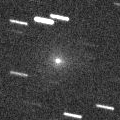
|
It was expected to brighten up to 11 mag in July. But actually, it was fainter than originally expected. Now it is 16.1 mag (Sept. 1, Ken-ichi Kadota). Fading rapidly. It will be fainter than 18 mag in October. It locates somewhat low.
Date(TT) R.A. (2000) Decl. Delta r Elong. m1 Best Time(A, h)
Sept. 9 8 44.74 9 17.9 1.920 1.247 35 15.4 4:11 (268, 13)
Sept.16 9 3.99 7 23.1 1.960 1.310 37 16.0 4:17 (271, 15)
|
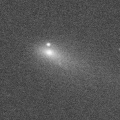
|
It brightened up to 12.8 mag in spring (Mar. 8, Taras Prystavski). Now it is 15.9 mag (Aug. 18, Ken-ichi Kadota). It will fade out rapidly after this. It will be fainter than 18 mag in November. It stays observable in good condition.
Date(TT) R.A. (2000) Decl. Delta r Elong. m1 Best Time(A, h)
Sept. 9 1 25.22 -3 51.5 1.626 2.523 145 15.7 2:16 ( 0, 51)
Sept.16 1 19.62 -4 22.7 1.623 2.561 153 15.8 1:43 ( 0, 51)
|

|
It will approach to Sun down to 0.4 a.u. in late September in 2024, and it is expected to brighten up to 0 mag. Now it is 16.2 mag (Sept. 3, Thomas Lehmann). Brightening slowly. It will be unobservable in October. But it will be observable again in November in the Northern Hemisphere, or in December in the Southern Hemisphere. At the high light, in the Northern Hemisphere, it will be observable in good condition after the perihelion passage. In the Southern Hemisphere, it will be observable in the low sky before and after the perihelion passage.
Date(TT) R.A. (2000) Decl. Delta r Elong. m1 Best Time(A, h)
Sept. 9 14 7.04 -0 21.2 6.120 5.457 45 15.8 19:42 ( 79, 15)
Sept.16 14 9.05 -0 50.3 6.127 5.387 39 15.7 19:31 ( 81, 11)
|

|
Now it is 15.7 mag (Aug. 24, Thomas Lehmann). Fading slowly. It stays observable in good condition.
Date(TT) R.A. (2000) Decl. Delta r Elong. m1 Best Time(A, h)
Sept. 9 0 38.74 -6 47.2 2.681 3.631 157 15.8 1:30 ( 0, 48)
Sept.16 0 34.56 -7 12.6 2.669 3.647 164 15.8 0:58 ( 0, 48)
|

|
Now it is 16.1 mag (Aug. 23, ATLAS South Africa). Fading gradually. It will be fainter than 18 mag in December. It locates somewhat low in the Northern Hemisphere. In the Southern Hemisphere, it will be getting lower gradually after this, and it will be unobservable in December.
Date(TT) R.A. (2000) Decl. Delta r Elong. m1 Best Time(A, h)
Sept. 9 17 20.13 -21 5.2 2.547 2.819 94 15.9 19:42 ( 25, 30)
Sept.16 17 26.96 -21 19.7 2.680 2.859 89 16.0 19:31 ( 28, 29)
|
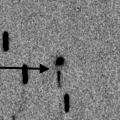
|
David Rankin detected its cometary activity in June. Now it is 16.1 mag (Sept. 5, ATLAS Chile). It stays 16 mag for a while. It stays observable in good condition.
Date(TT) R.A. (2000) Decl. Delta r Elong. m1 Best Time(A, h)
Sept. 9 22 13.75 -3 33.6 1.333 2.324 166 16.1 23:01 ( 0, 52)
Sept.16 22 10.09 -3 46.5 1.331 2.299 159 16.0 22:30 ( 0, 51)
|
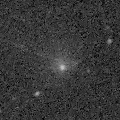
|
Very large comet. It is expected to brighten up to 13 mag in 2031. Now it is 15.7 mag (Aug. 19, Thomas Lehmann). It stays 16 mag for a while. In the Northern Hemisphere, it is not observable now. In the Southern Hemisphere, it stays observable in good condition. In the Northern Hemisphere, it is not observable until 2030.
Date(TT) R.A. (2000) Decl. Delta r Elong. m1 Best Time(A, h)
Sept. 9 3 33.56 -63 4.1 16.956 17.252 105 16.3 4:11 (359, -8)
Sept.16 3 32.86 -63 31.1 16.930 17.227 105 16.2 3:55 ( 0, -8)
|
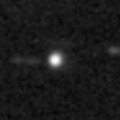
|
Now it is 16.6 mag (Sept. 4, H. Duin). Fading slowly. It will be fainter than 18 mag in January. It stays observable in good condition. It was very faint as 21.5 mag in 2021. It seems to be bright temporarily in outburst.
Date(TT) R.A. (2000) Decl. Delta r Elong. m1 Best Time(A, h)
Sept. 9 21 12.41 -11 38.0 3.614 4.521 150 16.3 22:00 ( 0, 43)
Sept.16 21 9.94 -11 46.8 3.686 4.535 143 16.4 21:30 ( 0, 43)
|
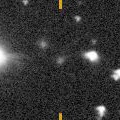
|
It is expected to brighten up to 14 mag in 2024 summer. At the high light, it is not observable in the Northern Hemisphere. Now it is 17.1 mag (Aug. 27, ATLAS Chile). It stays 16 mag for a while. It stays observable in good condition.
Date(TT) R.A. (2000) Decl. Delta r Elong. m1 Best Time(A, h)
Sept. 9 3 30.55 -1 31.2 3.640 4.157 114 16.5 4:11 (356, 54)
Sept.16 3 28.60 -3 25.1 3.498 4.109 121 16.4 3:51 ( 0, 52)
|
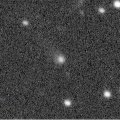
|
Now it is 16.5 mag (Apr. 10, Michael Jager). It stays 16 mag for a while. In the Northern Hemisphere, it is not observable now, but it will appear in October. In the Southern Hemisphere, it will be getting higher gradually.
Date(TT) R.A. (2000) Decl. Delta r Elong. m1 Best Time(A, h)
Sept. 9 9 17.70 -27 46.4 4.386 3.708 42 16.4 4:11 (294,-15)
Sept.16 9 22.02 -29 44.8 4.344 3.705 45 16.4 4:17 (299,-11)
|

|
It is expected to brighten up to 14.5 mag in winter. Now it is 17.4 mag (Sept. 1, Ken-ichi Kadota). Brightening slowly. It stays observable in good condition.
Date(TT) R.A. (2000) Decl. Delta r Elong. m1 Best Time(A, h)
Sept. 9 3 26.58 14 6.4 2.229 2.779 112 16.6 4:11 (356, 69)
Sept.16 3 29.59 14 26.8 2.112 2.742 118 16.4 3:52 ( 0, 70)
|
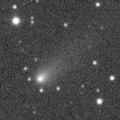
|
Now it is 16.1 mag (Sept. 1, ATLAS South Africa). Fading slowly. It will be fainter than 18 mag in November. In the Northern Hemisphere, it will never be observable after this. In the Southern Hemisphere, it will be getting lower gradually.
Date(TT) R.A. (2000) Decl. Delta r Elong. m1 Best Time(A, h)
Sept. 9 15 0.68 -38 20.2 2.738 2.566 69 16.4 19:42 ( 42, -1)
Sept.16 15 14.09 -38 54.3 2.827 2.584 65 16.6 19:31 ( 42, -2)
|

|
It will brighten rapidly after this. It will be unobservable in October. But it will be observable again in November.
Date(TT) R.A. (2000) Decl. Delta r Elong. m1 Best Time(A, h)
Sept. 9 8 18.50 20 58.8 1.515 1.050 43 16.9 4:11 (261, 24)
Sept.16 8 51.52 17 59.4 1.387 0.932 42 16.6 4:17 (264, 23)
|
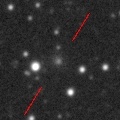
|
Now it is 17.2 mag (Sept. 3, A. Diepvens). It stays 17 mag for a while. In the Northern Hemisphere, it stays observable in good condition. In the Southern Hemisphere, it will be getting lower gradually after this, and it will be unobservable in December.
Date(TT) R.A. (2000) Decl. Delta r Elong. m1 Best Time(A, h)
Sept. 9 17 52.04 -11 30.0 2.164 2.570 101 16.7 19:42 ( 20, 41)
Sept.16 17 57.52 -11 44.9 2.232 2.553 96 16.7 19:31 ( 24, 40)
|

|
Very far object. Now it is 17.0 mag (Aug. 26, Jean-Claude Merlin). It stays 17 mag for a while. In the Northern Hemisphere, it is not observable now. In the Southern Hemisphere, it stays observable in good condition.
Date(TT) R.A. (2000) Decl. Delta r Elong. m1 Best Time(A, h)
Sept. 9 5 46.86 -72 27.1 10.228 10.319 92 16.8 4:11 (349,-20)
Sept.16 5 43.97 -73 9.7 10.234 10.318 92 16.8 4:17 (352,-20)
|

|
It has not been observed yet in this apparition. It tends to brighten after the perihelion passage. It will fade out rapidly after this. It will be fainter than 18 mag in November. In the Northern Hemisphere, it will never be observable after this. In the Southern Hemisphere, it will be unobservable in October.
Date(TT) R.A. (2000) Decl. Delta r Elong. m1 Best Time(A, h)
Sept. 9 12 38.75 -2 0.2 2.209 1.352 24 17.0 19:42 ( 90, -4)
Sept.16 13 1.91 -4 8.8 2.225 1.361 23 16.8 19:31 ( 87, -4)
|

|
It brightened up to 14.1 mag in 2022 spring (Mar. 22, 2022, Chris Wyatt). It was expected to brighten up to 13 mag. But actually, it was fainter than originally expected. Now it is 16.3 mag (Aug. 29, ATLAS South Africa). It stays 17 mag for a while. It stays observable in good condition.
Date(TT) R.A. (2000) Decl. Delta r Elong. m1 Best Time(A, h)
Sept. 9 2 49.39 -2 34.6 4.532 5.171 124 16.9 3:40 ( 0, 53)
Sept.16 2 44.06 -2 36.2 4.489 5.218 132 16.9 3:07 ( 0, 52)
|
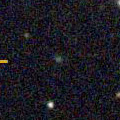
|
Now it is 17.5 mag (Aug. 26, ATLAS-HKO, Haleakala). It stays 17 mag for a while. In the Northern Hemisphere, it stays observable in good condition. It stays extremely low in the Southern Hemisphere.
Date(TT) R.A. (2000) Decl. Delta r Elong. m1 Best Time(A, h)
Sept. 9 4 56.01 38 28.4 6.678 6.731 88 17.0 4:11 (253, 71)
Sept.16 4 58.41 38 51.9 6.567 6.726 94 17.0 4:17 (248, 77)
|

|
It brightened up to 13.4 mag in last summer (July 7, 2022, Giuseppe Pappa). Now it is 17.2 mag (Aug. 25, ATLAS-HKO, Haleakala). It stays 18 mag for a while. In the Northern Hemisphere, it will be getting lower gradually. But it will be getting higher again after November. In the Southern Hemisphere, it will be unobservable in October.
Date(TT) R.A. (2000) Decl. Delta r Elong. m1 Best Time(A, h)
Sept. 9 15 20.35 30 32.2 4.869 4.522 64 17.1 19:42 (100, 45)
Sept.16 15 21.84 30 9.1 4.980 4.569 60 17.2 19:31 (101, 42)
|

|
Now it is 16.7 mag (Aug. 28, Ken-ichi Kadota). It stays 17 mag for a while. It stays observable in good condition.
Date(TT) R.A. (2000) Decl. Delta r Elong. m1 Best Time(A, h)
Sept. 9 4 56.69 -10 14.2 7.437 7.568 93 17.1 4:11 (329, 39)
Sept.16 4 57.95 -10 32.1 7.311 7.536 99 17.1 4:17 (339, 42)
|
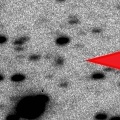
|
Now it is 17.8 mag (Sept. 1, ATLAS South Africa). It stays 17 mag for a while. It will be unobservable in October in the Northern Hemisphere, or in November in the Southern Hemisphere. But it will be observable again in December in the Southern Hemisphere. It stays 16 mag in the Southern sky for a long time from 2024 to 2025.
Date(TT) R.A. (2000) Decl. Delta r Elong. m1 Best Time(A, h)
Sept. 9 16 26.42 -39 54.7 6.429 6.434 85 17.1 19:42 ( 28, 8)
Sept.16 16 24.70 -39 46.1 6.521 6.405 78 17.1 19:31 ( 31, 6)
|

|
It is expected to brighten up to 7 mag, and it will be observable in good condition in winter. Now it is 19.2 mag (Aug. 30, F. Kugel, J. Nicolas). Brightening rapidly. In the Northern Hemisphere, it stays observable in good condition. It locates somewhat low in the Southern Hemisphere. But it will become high in winter.
Date(TT) R.A. (2000) Decl. Delta r Elong. m1 Best Time(A, h)
Sept. 9 5 2.61 20 9.7 1.457 1.760 89 17.7 4:11 (297, 63)
Sept.16 5 21.09 20 42.9 1.354 1.710 91 17.1 4:17 (301, 66)
|

|
It is expected to brighten up to 15 mag from autumn to winter. Now it is 18.4 mag (Aug. 27, J. L. Virlichie, P. Traverse, H. Roy). Brightening slowly. In the Northern Hemisphere, it is not observable now, but it will appear in October. In the Southern Hemisphere, it stays observable in good condition.
Date(TT) R.A. (2000) Decl. Delta r Elong. m1 Best Time(A, h)
Sept. 9 2 56.62 -58 10.2 1.439 2.037 111 17.5 3:47 ( 0, -3)
Sept.16 2 49.47 -58 45.6 1.395 2.008 112 17.2 3:12 ( 0, -4)
|
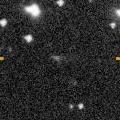
|
First return of a new periodic comet which brightened up to 15 mag in 2008. Now it is 17.4 mag (Aug. 3, Ken-ichi Kadota). Fading gradually. It will be fainter than 18 mag in November. It stays observable in good condition.
Date(TT) R.A. (2000) Decl. Delta r Elong. m1 Best Time(A, h)
Sept. 9 3 59.70 19 44.4 2.125 2.561 103 17.4 4:11 (328, 73)
Sept.16 4 4.07 18 47.3 2.065 2.586 109 17.4 4:17 (352, 74)
|

|
Now it is 17.3 mag (Aug. 27, ATLAS Chile). It stays 18 mag for a while. It stays observable in good condition.
Date(TT) R.A. (2000) Decl. Delta r Elong. m1 Best Time(A, h)
Sept. 9 3 54.00 8 25.0 2.571 3.027 107 17.6 4:11 (342, 62)
Sept.16 3 56.78 8 5.3 2.496 3.037 113 17.5 4:17 (359, 63)
|
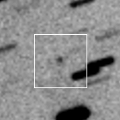
|
Now it is 17.9 mag (Aug. 28, Ken-ichi Kadota). It stays 17 mag for a while. In the Northern Hemisphere, it stays observable in good condition. In the Southern Hemisphere, it is not observable now, but it will appear in November.
Date(TT) R.A. (2000) Decl. Delta r Elong. m1 Best Time(A, h)
Sept. 9 2 13.41 56 15.0 4.112 4.517 107 17.6 3:05 (180, 69)
Sept.16 1 58.01 57 13.7 4.006 4.496 113 17.5 2:22 (180, 68)
|

|
Now it is 18.2 mag (Sept. 4, ATLAS-HKO, Haleakala). It stays 17 mag for a while. In the Northern Hemisphere, it stays observable in good condition. It stays extremely low in the Southern Hemisphere.
Date(TT) R.A. (2000) Decl. Delta r Elong. m1 Best Time(A, h)
Sept. 9 5 0.91 39 8.5 5.386 5.440 87 17.7 4:11 (251, 70)
Sept.16 5 4.14 39 9.7 5.258 5.415 93 17.6 4:17 (248, 75)
|

|
Now it is 17.6 mag (Aug. 7, Hirohisa Sato). It stays 18 mag for a while. In the Northern Hemisphere, it will be getting lower gradually. It stays extremely low in the Southern Hemisphere.
Date(TT) R.A. (2000) Decl. Delta r Elong. m1 Best Time(A, h)
Sept. 9 15 8.04 28 38.9 3.270 2.921 61 17.7 19:42 ( 99, 42)
Sept.16 15 19.82 26 39.5 3.316 2.931 59 17.7 19:31 ( 97, 40)
|

|
Now it is 17.7 mag (Sept. 5, Jean-Claude Merlin). Fading slowly. It will be fainter than 18 mag in October. It stays observable in good condition.
Date(TT) R.A. (2000) Decl. Delta r Elong. m1 Best Time(A, h)
Sept. 9 22 55.14 -16 55.7 2.059 3.052 168 17.8 23:42 ( 0, 38)
Sept.16 22 51.36 -17 48.1 2.084 3.057 162 17.9 23:11 ( 0, 37)
|

|
It brightened up to 14 mag from 2020 to 2021. Now it is 17.9 mag (Aug. 24, W. Hasubick). It stays 18 mag for a while. It stays observable in good condition.
Date(TT) R.A. (2000) Decl. Delta r Elong. m1 Best Time(A, h)
Sept. 9 3 9.65 4 30.6 4.139 4.707 118 17.9 4:00 ( 0, 60)
Sept.16 3 8.62 4 17.6 4.062 4.719 125 17.9 3:32 ( 0, 59)
|

|
It returned for the first time in 68 years. It will brighten up to 7.5 mag in 2024 summer. Now it is 21.0 mag (Aug. 26, Alan Hale). It will brighten rapidly after this. It stays observable in good condition. At the high light, it locates low in the Northern Hemisphere, or it is not observable in the Southern Hemisphere.
Date(TT) R.A. (2000) Decl. Delta r Elong. m1 Best Time(A, h)
Sept. 9 4 26.14 -16 3.9 3.532 3.861 101 20.1 4:11 (340, 37)
Sept.16 4 27.58 -16 40.9 3.385 3.794 106 19.9 4:17 (350, 38)
|
|
![]()
 185P/Petriew
185P/Petriew 71P/Clark
71P/Clark C/2023 A3 ( Tsuchinshan-ATLAS )
C/2023 A3 ( Tsuchinshan-ATLAS ) 117P/Helin-Roman-Alu 1
117P/Helin-Roman-Alu 1 81P/Wild 2
81P/Wild 2 P/2023 KF3
P/2023 KF3 C/2014 UN271 ( Bernardinelli-Bernstein )
C/2014 UN271 ( Bernardinelli-Bernstein ) P/2023 M4 ( ATLAS )
P/2023 M4 ( ATLAS ) C/2022 S4 ( Lemmon )
C/2022 S4 ( Lemmon ) C/2022 A3 ( Lemmon-ATLAS )
C/2022 A3 ( Lemmon-ATLAS ) 32P/Comas Sola
32P/Comas Sola 77P/Longmore
77P/Longmore (3200) Phaethon
(3200) Phaethon 219P/LINEAR
219P/LINEAR C/2019 E3 ( ATLAS )
C/2019 E3 ( ATLAS ) 339P/Gibbs
339P/Gibbs C/2020 Y2 ( ATLAS )
C/2020 Y2 ( ATLAS ) C/2021 S4 ( Tsuchinshan )
C/2021 S4 ( Tsuchinshan ) C/2020 R7 ( ATLAS )
C/2020 R7 ( ATLAS ) C/2022 QE78 ( ATLAS )
C/2022 QE78 ( ATLAS ) C/2023 F3 ( ATLAS )
C/2023 F3 ( ATLAS ) 62P/Tsuchinshan 1
62P/Tsuchinshan 1 226P/Pigott-LINEAR-Kowalski
226P/Pigott-LINEAR-Kowalski 465P/2023 L1 ( Hill )
465P/2023 L1 ( Hill ) 170P/Christensen
170P/Christensen C/2022 U1 ( Leonard )
C/2022 U1 ( Leonard ) C/2022 U3 ( Bok )
C/2022 U3 ( Bok ) C/2022 U4 ( Bok )
C/2022 U4 ( Bok ) 287P/Christensen
287P/Christensen 246P/NEAT
246P/NEAT 13P/Olbers
13P/Olbers![]()






















































